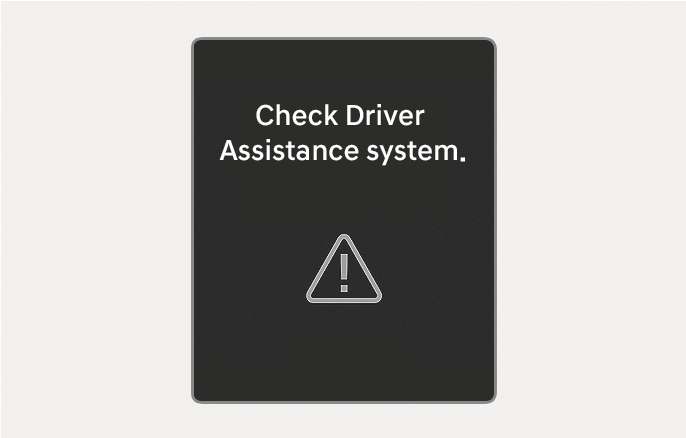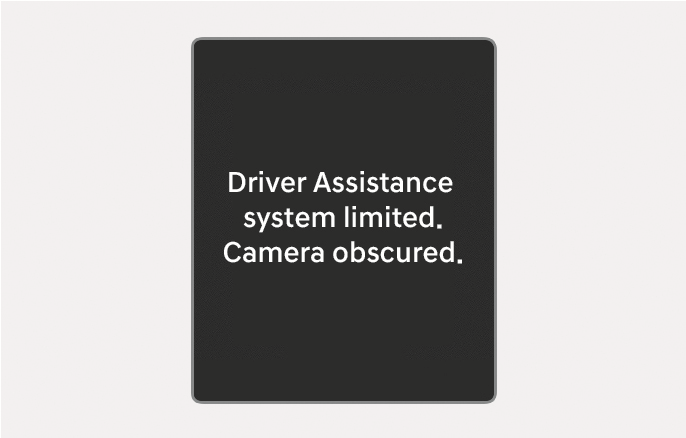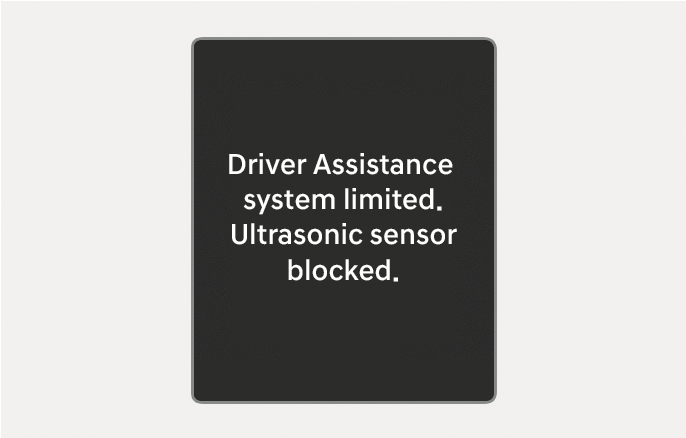Reverse Parking Collision-Avoidance Assist Malfunction and Limitations

2C_DriverAssistanceMalfunction
When Reverse Parking Collision-Avoidance Assist or other related functions are not working properly, the "Check Driver Assistance system." warning message appears on the instrument cluster, and Reverse Parking Collision-Avoidance Assist turns off automatically. Have your vehicle inspected by an authorized HYUNDAI dealer.

2C_DriverAssistanceLimitedCamera

2C_DriverAssistanceLimitedUltrasonic
The "Driver Assistance system limited. Camera obscured." or "Driver Assistance system limited. Ultrasonic sensor blocked." warning message appears on the instrument cluster if the following situations occur:
-
The wide-rear view camera or rear ultrasonic sensor(s) is covered with foreign material, such as snow or rain, etc.
-
There is inclement weather, such as heavy snow, heavy rain, etc.
If this occurs, Reverse Parking Collision-Avoidance Assist may turn off or may not operate properly. Check whether the wide-rear view camera and rear ultrasonic sensors are clean.
Reverse Parking Collision-Avoidance Assist may not assist braking or warn the driver even if there are pedestrians or objects under the following circumstances:
-
Problems with vehicle
-
Any non-factory equipment or accessory is installed
-
Your vehicle is unstable due to a crash or other causes
-
Bumper height or rear ultrasonic sensor installation has been modified
-
Wide-rear view camera(s) or ultrasonic sensor(s) is damaged
-
Wide-rear view camera(s) or the ultrasonic sensor(s) is stained with foreign material, such as snow, dirt, etc.
-
Wide-rear view camera(s) is obscured by a light source or by inclement weather, such as heavy rain, fog, snow, etc.
-
-
Problems with the surroundings
-
The surrounding is very bright or very dark
-
Outside temperature is very high or very low
-
The wind is either strong (above 12 mph (20 km/h)) or blowing perpendicular to the rear bumper
-
Objects generating excessive noise, such as vehicle horns, loud motorcycle vehicles or truck air brakes, are near your vehicle
-
An ultrasonic sensor with similar frequency is near your vehicle
-
The road is slippery or inclined
-
The image of the pedestrian in the front view camera is indistinguishable from the background
-
-
Problems with pedestrian or object
-
The pedestrians are difficult to detect
-
There is ground height difference between the vehicle and the pedestrian
-
The pedestrian is near the rear edge of the vehicle
-
The pedestrian is not standing upright
-
The pedestrian is either very short or very tall to detect
-
The pedestrian or cyclist is wearing clothing that easily blends into the background, making it difficult to detect
-
The pedestrian is wearing clothing that does not reflect ultrasonic waves well
-
Size, thickness, height, or shape of the object does not reflect ultrasonic waves well (for example, low object, narrow object, circular pillar, small pillar, corners of a square pillar, bush, curbs, carts, edge of a wall, etc.)
-
The pedestrian or the object is moving
-
The pedestrian or the object is very close to the rear of the vehicle
-
There is a large object such as a wall is behind the pedestrian or the object
-
The object is not located at the front or rear center of your vehicle
-
The object is not parallel to the rear bumper
-
The sensors cannot detect the pedestrians and objects
-
-
Problems with driving condition
-
The driver drives the vehicle immediately after shifting to R (Reverse) or D (Drive)
-
The driver accelerates or circles the vehicle
-
The vehicle is driven immediately after starting the vehicle
-
Take the following precautions when using Reverse Parking Collision-Avoidance Assist:
-
Always exercise extreme caution while driving. The driver is responsible for braking and safe driving.
-
Always pay attention to road and traffic conditions while driving, whether or not there is a warning.
-
Always look around your vehicle to make sure there are no pedestrians or objects before moving the vehicle.
-
The performance of Reverse Parking Collision-Avoidance Assist may vary under certain conditions. If vehicle speed is above 2 mph (4 km/h), Reverse Parking Collision-Avoidance Assist will provide collision avoidance assist only when pedestrians are detected. Always look around and pay attention when driving your vehicle.
-
Reverse Parking Collision-Avoidance Assist may operate differently under certain conditions. If the vehicle moves forward and backward repeatedly, Reverse Parking Collision-Avoidance Assist may fail to assist braking or to warn the driver. Always pay attention when driving your vehicle.
-
Some objects may not be detected by the rear ultrasonic sensors due to the objects distance, size or material, all of which can limit the effectiveness of the sensor.
-
Reverse Parking Collision-Avoidance Assist may not operate properly or may operate unnecessarily depending on the road conditions and the surroundings.
-
Do not solely rely on Parking Collision-Avoidance Assist. Doing so may lead to vehicle damage or injuries.
-
Noise may be heard when sudden braking occurs to avoid a collision.
-
If any other warning sound such as the seat belt warning chime is already generated, Parking Collision-Avoidance Assist warning may not sound.
-
Parking Collision-Avoidance Assist may not work properly if the bumper has been damaged, replaced or repaired.
-
Parking Collision-Avoidance Assist may not operate properly if interfered by strong electromagnetic waves.
-
Playing the vehicle audio system at high volume may prevent passengers from hearing Parking Collision-Avoidance Assist warning sounds.
-
Turn off Parking Collision-Avoidance Assist when towing a trailer. If towing and moving in reverse, Parking Collision-Avoidance Assist will activate as it detects the trailer.
-
The brake control may not operate properly depending on the status of ESC (Electronic Stability Control).
There will only be a warning when:
-
The ESC (Electronic Stability Control) warning light is on
-
ESC (Electronic Stability Control) is engaged in a different function
-
Take the following precautions to maintain optimal performance of the detecting sensors:
-
Always keep the wide-rear view cameras and ultrasonic sensors clean.
-
Do not use any cleanser containing acid or alkaline detergents when cleaning the camera lens. Use only a mild soap or neutral detergent, and rinse thoroughly with water.
-
Do not spray the wide-rear view cameras or the rear ultrasonic sensors or their surrounding area directly with a high pressure washer. It may cause the wide angle cameras or the ultrasonic sensors to malfunction.
-
Do not apply objects, such as a bumper sticker or a bumper guard, near the wide angle cameras or ultrasonic sensors or apply paint to the bumper. Doing so may adversely affect the performance of Parking Collision-Avoidance Assist.
-
Never disassemble or apply impact on the wide angle cameras or the ultrasonic sensors components.
-
Do not apply unnecessary force on the wide-rear view cameras or the ultrasonic sensors. Reverse Parking Collision-Avoidance Assist may not operate properly if the wide angle cameras or the ultrasonic sensor(s) is forcibly moved out of proper alignment. Have your vehicle inspected by an authorized HYUNDAI dealer.
Reverse Parking Collision-Avoidance Assist can detect a pedestrian or an object when:
-
A pedestrian is standing behind the vehicle
-
A large obstacle, such as a vehicle, is parked in the rear center of your vehicle